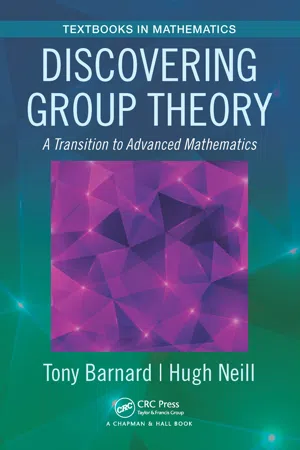
- 219 pages
- English
- ePUB (mobile friendly)
- Available on iOS & Android
About this book
Discovering Group Theory: A Transition to Advanced Mathematics presents the usual material that is found in a first course on groups and then does a bit more. The book is intended for students who find the kind of reasoning in abstract mathematics courses unfamiliar and need extra support in this transition to advanced mathematics.
The book gives a number of examples of groups and subgroups, including permutation groups, dihedral groups, and groups of integer residue classes. The book goes on to study cosets and finishes with the first isomorphism theorem.
Very little is assumed as background knowledge on the part of the reader. Some facility in algebraic manipulation is required, and a working knowledge of some of the properties of integers, such as knowing how to factorize integers into prime factors.
The book aims to help students with the transition from concrete to abstract mathematical thinking.
Frequently asked questions
- Essential is ideal for learners and professionals who enjoy exploring a wide range of subjects. Access the Essential Library with 800,000+ trusted titles and best-sellers across business, personal growth, and the humanities. Includes unlimited reading time and Standard Read Aloud voice.
- Complete: Perfect for advanced learners and researchers needing full, unrestricted access. Unlock 1.4M+ books across hundreds of subjects, including academic and specialized titles. The Complete Plan also includes advanced features like Premium Read Aloud and Research Assistant.
Please note we cannot support devices running on iOS 13 and Android 7 or earlier. Learn more about using the app.
Information
1
Proof
1.1 The Need for Proof

“Proof” that the angles of a triangle add to 180°.
1.2 Proving by Contradiction
Table of contents
- Cover
- Half Title
- Title Page
- copyright Page
- Table of Contents
- Preface
- 1. Proof
- 2. Sets
- 3. Binary Operations
- 4. Integers
- 5. Groups
- 6. Subgroups
- 7. Cyclic Groups
- 8. Products of Groups
- 9. Functions
- 10. Composition of Functions
- 11. Isomorphisms
- 12. Permutations
- 13. Dihedral Groups
- 14. Cosets
- 15. Groups of Orders Up To 8
- 16. Equivalence Relations
- 17. Quotient Groups
- 18. Homomorphisms
- 19. The First Isomorphism Theorem
- Answers
- Index